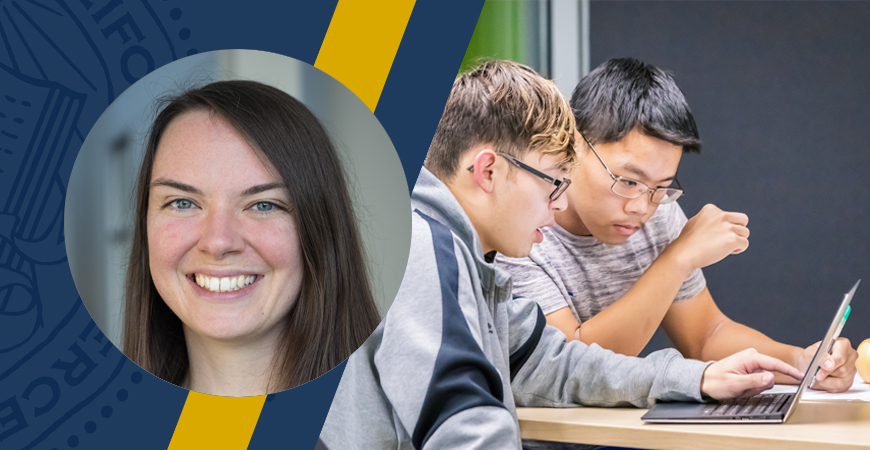
Students who take part in active learning — engaging directly with the instruction process — learn more than they would from an excellent lecture, though they think they learned less, according to a study co-authored by a UC Merced lecturer.
The study, originally published in Proceedings of the National Academy of Sciences and revisited in September by the prestigious journal Science as part of a wide-ranging look at active learning, challenges the pervasive sit-and-listen approach to teaching in higher education. It also questions the dependence on student surveys to assess a course’s effectiveness.
Kristina Callaghan, a lecturer in the School of Natural Sciences, was a graduate student at Harvard University when she and a team of researchers performed the experiment. Half the students in an introductory physics course were assigned to small groups to perform an in-class activity, then received instructor feedback. The other half listened to a well-presented lecture. Identical course materials were used. Roles were reversed in the subsequent class session.
The students were then surveyed on their perceptions of how well they picked up the material — and tested to determine how much they actually learned. The students overwhelmingly thought they learned more from the lecture. But they hadn’t.
“There’s a cognitive dissonance because you sit there, receiving information, and think, ‘Yeah, I’m learning a lot,’” Callaghan said. And they are learning something, of course — just not as much as when they actively engage with the material and each other.
“You’ve got to do it yourself,” said Callaghan, who joined UC Merced in 2018.
The Harvard study was among seven articles collected in the Science report, which framed active learning within the disruption of a global health emergency.
“Widespread disruptions to schooling spurred by COVID-19 have amplified long-standing discussions about what high-quality teaching and learning can be,” the report begins. “Growing bodies of research and practice … demonstrate the benefits of moving beyond traditional lecture-driven approaches in favor of active learning.”
Examples of active learning include group discussion, role-playing, peer review, simulations — even quiet periods of reflection. Activities can be interspersed within lecture time or stretched over multiple class sessions.
There are a lot of active-learning techniques that aren’t time-intensive. An easy one to do is just stop talking, let the students ask each other questions, then get their feedback.
Callaghan uses active learning regularly in the physics courses she teaches. For instance, she will spend three to five minutes introducing a concept then give students an equal amount of time in a structured group activity while Callaghan and learning assistants roam the room, assisting groups of students.
“Then, in addition to what I was planning to present, I give them targeted feedback. ‘Oh, I saw some of you were doing this.’ And we repeat this for the next topic,” Callaghan said.
She also will have her students take a test individually, then complete the same exam again in a group of three or four.
“I tell my students, ‘We believe in collaborative learning so much that even our exams are going to be collaborative.’”
If active learning has demonstrable advantages over passive learning, why isn’t it employed more often? The study indicated resistance comes not necessarily from instructors but from students.
After the experiments were complete, subjects in the study told the researchers that the active sessions seemed loose and unstructured while the lectures felt fluid and easy to follow. The study said these perceptions support the idea that some students have a tough time judging what they learned and instead "rely on inaccurate metacognitive cues such as fluency of instruction."
Callaghan said an effective way to mitigate students’ concerns about active learning is, ironically, a shorter lecture. Before any collaborative activity, she briefly explains how it works and her rationale for using it. This approach continues throughout the semester.
“There’s always an open line of communication so they can let me know what questions they have or anything they were confused by. We even have questions that we carry over to the next class session.”
As for colleagues who might want to try active-learning techniques but aren’t sure how to begin, she recommends starting small.
“There are a lot of active-learning techniques that aren’t time-intensive. An easy one to do is just stop talking, let the students ask each other questions, then get their feedback,” Callaghan said. “On the other end of the spectrum is project-based learning, which is much more resource-intensive.”
“Just pick something that you can add. Make it an iterative process. Add something else the next semester. Make a gradual shift toward a more active approach as compared to lecture-based instruction.”






